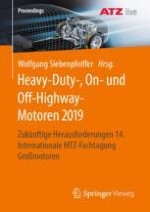2020 | OriginalPaper | Chapter
A novel low-cost aftertreatment solution for lean‑burn gas engines
Authors : Matthew Keenan, Jacques Nicole, Ben Rogers
Published in: Heavy-Duty-, On- und Off-Highway-Motoren 2019
Publisher: Springer Fachmedien Wiesbaden
Activate our intelligent search to find suitable subject content or patents.
Select sections of text to find matching patents with Artificial Intelligence. powered by
Select sections of text to find additional relevant content using AI-assisted search. powered by
Lean burn methane fueled combustion engines give low tailpipe CO2 emissions compared to diesel and stoichiometric natural gas applications. Optimised engine efficiency by operating lean combined with a low carbon containing fuel lead to the lowest possible tailpipe CO2 for a non-hybridized system. However, due to the lean combustion mode, both NOx and CH4 become a challenge for exhaust emissions control. Traditionally, urea based SCR is used to control NOx and a highly loaded precious metal based methane oxidation catalyst (MOC) is used to attempt to achieve low tailpipe CH4 emissions. Therefore, due to the number of catalyst and the associated control requirements, the cost of the combined aftertreatment solution becomes a significant proportion of the total engine cost. In addition to the high cost of the methane control catalyst, the MOC only becomes highly efficiency in the region of 500°C, which for lean operating engines is rarely reached under normal engine operation.Due to the high temperature stability of methane, a novel approach has been taken to develop a catalyst system which is able to oxidise methane at low temperatures, via the use of alternative oxidising agents. Dioxygen (O2) is relatively stable, whereas ozone (O3) is highly reactive and is a significantly stronger oxidising agent compared to O2. Synthetic gas reactor experiments were performed using O3 as the oxidising agent and methane as the hydrocarbon feed. A current production iron based SCR catalyst was used and was found to oxidise methane at 220°C with an efficiency of >60%. Experiments are continuing with a multi staged fixed bed reactor with the aim of demonstrating >95% conversion, leading to the potential to eliminate the expensive PGM based MOC. These results will be presented at the conference. There is a cost associated with the on-board O3 generator and the associated power consumption needs to be included in the engine efficiency. However, the solution is anticipated to deliver a significant GHG (CO2 + CH4 equivalent) reduction compared with diesel and stoichiometric NG solutions but at an aftertreatment cost that is lower than diesel and equivalent to stoichiometric NG. This paper will discuss the novel approach to emissions control utilising an alternative oxidising agent for low temperature and low cost emissions control, including the advantages and disadvantages of the system for different applications.
